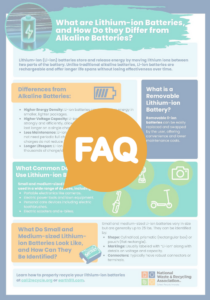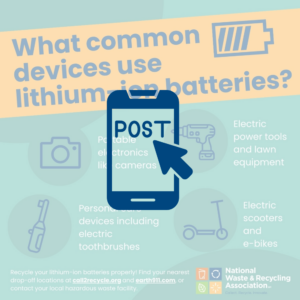You Can Prevent Lithium-ion Battery Fires
Lithium-ion batteries help power millions of devices that people use every day, from cameras, e-bikes, and e-cigarettes to even some lawn equipment. But improper disposal of these effective power sources can be dangerous, putting recycling and waste industry workers and communities at risk. We need you to join the collective effort to ensure these batteries are properly managed.
What Are Lithium-ion Batteries?
Lithium-ion batteries are a type of rechargeable batteries that use lithium in their anode and cathode. An electrolyte carries charged lithium-ions through a separator from the cathode to the anode to charge the battery and vice versa as the charge is released. Unlike traditional alkaline batteries, lithium-ion batteries typically offer longer life spans without losing effectiveness over time. Removable lithium-ion batteries are rechargeable and can be easily replaced and swapped by users, offering convenience and lower maintenance costs.
Examples of everyday items that may contain removeable and rechargeable lithium-ion batteries:
- Electronics such as cameras, drones and some laptops.
- Small electric vehicles like scooters and e-bikes.
- Electric power tools and lawn equipment.
- Personal care devices such as electric toothbrushes.
Other products like headphones, cell phones, tablets, smart watches and portable e-readers can contain embedded lithium-ion batteries that cannot be removed. If it can be plugged in to be recharged and can beep, wiggle or blink, then it likely has a lithium-ion battery.
Why Do You Need to Properly Dispose of Lithium-ion Batteries?
Lithium-ion batteries should never be thrown in your household waste or recycling carts as they can spark dangerous fires or explosions if they are damaged, crushed or broken. A dead lithium-ion battery is a “zombie battery” in that it can rise from the dead and cause fires if the separator between the anode and cathode is damaged.
Lithium-ion batteries can start fires in recycling and waste trucks or facilities, which may cause:
- Delays in recycling and waste collection that could lead to service disruptions for residents and local businesses.
- Damage to equipment and facilities.
- Life-threatening situations that could disrupt the recycling and waste facility’s operations and damage infrastructure.
- Higher costs for customers and local municipalities.
- Strain on local emergency response systems that put local firefighters in harm’s way.
How Do You Properly Manage and Dispose of Lithium-ion Batteries?
Lithium-ion batteries should not be put in recycling carts or disposed of with household waste due to the risk of fire and environmental harm.
To properly dispose of lithium-ion batteries, visit www.call2recycle.org/locator, Earth911.com or your local government website to find the nearest drop-off locations for your used or unwanted lithium-ion batteries.
To safely transport your unwanted lithium-ion batteries, make sure the terminals are covered using duct tape to prevent them from rubbing together and sparking while in transit.
Thank you for helping prevent lithium-ion battery fires by ensuring they are managed and disposed of properly.
Resources
Resource Recycling Systems (RRS) Lithium-ion Battery Opinion Paper


